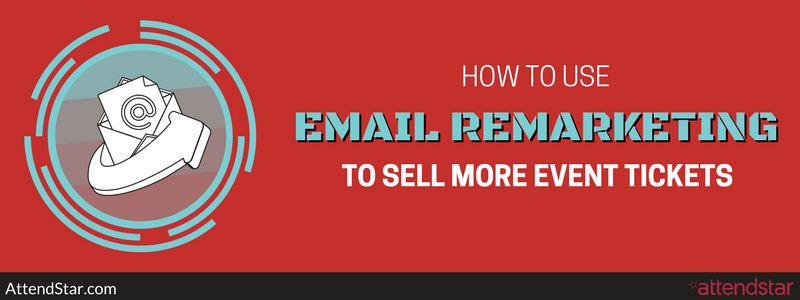Ad retargeting is a great way to sell more tickets to people who visit your event’s ticket sales page, but email remarketing is an even better way to re-engage your email subscribers (including those who add their email addresses on your ticket sales page but leave without buying).
What is Email Remarketing?
Email remarketing includes shopping cart abandonment messages, upsell messages, and re-engagement messages to re-engage with people who haven’t bought from you in a while. It also includes website visitor re-engagement messages. These are messages you can send to subscribers who receive one of your email campaigns promoting your upcoming event, follow the link in the message to visit the ticket sales page, but leave without buying tickets. Similarly, you can send these messages to people who visit your ticket sales page and provide their email addresses but never finish a transaction.
Email remarketing is extremely effective because you’re communicating with people who already expressed interest in your event by clicking on the link in an email campaign or submitting their email addresses on your ticket sales page. AttendStar offers email remarketing campaign services and sees amazing results for events that use email remarketing.
For example, an email remarketing campaign that AttendStar ran for an air show this month had a message open rate of more than 46% and a click-through rate of nearly 13%. The event organizer sold hundreds of additional tickets and recouped thousands of dollars in revenue that may have been lost otherwise!
Creating Your Email Remarketing Campaign
Before you write your remarketing campaign email messages, you need to strategize how the campaign will work. I recommend a three message sequence for remarketing. Here’s a short peak inside what that campaign might include:
Message 1: Reminder
The first message should be sent within an hour of the recipient leaving your ticket sales page without buying. The goal at this point is to gently remind people about the great features of the event, so you can build their emotional connection to it. Write a message that makes them feel like they should get their tickets now so they don’t forget to buy later.
Also, I like to include information about a feature of the event that they might not have noticed when they viewed your ticket sales page. Including new information in your reminder message adds value to it in consumers’ minds.
Message 2: What You’re Missing
One day after the first email message is sent, you should send message two in the remarketing sequence. You want to keep the emotional connection to the event alive, and the longer you wait, the less intense the emotions that motivated the recipient to visit your ticket sales page in the first place will be.
In this message, you should make sure the recipient understands all of the great things they’ll miss if they don’t get tickets to the event. Use images, videos, and testimonials to bring the event to life in their email inboxes.
Message 3: Time’s Running Out
Two to three days after the second message is sent, the third message in the sequence should go out. This is your last chance to re-engage recipients, so don’t be afraid to promote. For example, this is a great time to mention any extras that people can get by purchasing tickets in advance. For example, if they can get a discount by buying online, free parking, discounted concession items, or even buy merchandise and concessions items in advance (e.g., AttendStar offers this to clients), make sure you talk about it in this message.
If you’re willing to give a discount on ticket prices to boost sales, you should offer that discount in this email message. Be sure to make the expiration date for the ticket discount very soon to create a sense of urgency and motivate people to buy as early as possible. For example, the ticket discount could be good for 24 or 48 hours only. I’d advise testing your results with and without adding a discount (i.e., do an A/B split test) to determine if a discount is actually necessary to increase sales. Read the next section to learn more about testing.
5 Ts to Create a Successful Email Remarketing Campaign
A successful email remarketing campaign requires planning, experimenting, and making changes to optimize results. Follow the five Ts of a successful email remarketing campaign below as you create your first campaign:
- Timing – I’ve given you a timing sequence that has proven to be effective in email remarketing, but don’t be afraid to try different timing to see what works best for your campaign.
- Testing – Test your content, offers, timing, message length, subject line, and other message elements to create the best campaign that drives the highest results.
- Tracking – Use an email marketing service provider or a ticketing company that enables you to track the results of your campaign.
- Tweaking – Once you analyze the results of your campaign and testing, make changes to optimize your campaign.
- Try Again – Email remarketing isn’t a once and done thing. Optimization often takes more than one try.
Your Next Steps
Think about why people leave your ticket sales page without buying. Perhaps they didn’t have time to buy, didn’t have a credit card on hand, thought the ticket price was too high, or had technical problems. These are all obstacles that you can address in your remarketing campaign to make it as easy as possible for people to buy tickets to your event. The one thing I can tell you with certainty is the sooner you start using email remarketing, the sooner you’ll sell more tickets.
If you need assistance with your email remarketing campaigns, contact Gary Bradshaw at AttendStar (615-223-1973) or use the Contact Us Form for help selling tickets and regaining sales that you don’t want to lose!
Save
Save



